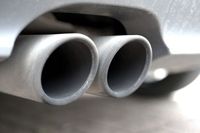Diesel Particulate Filter problems and how to avoid them

Diesel cars, although extremely popular because of their speed and comfort of driving, have one major drawback. They produce exhaust fumes contaminated with soot and solid particles which negatively affect the environment and our health. Particulate filters are installed to eliminate exhaust fumes. However, they can cause many problems. What are DPF failures and how can you prevent them?
What is a particulate filter?
DPF stands for Diesel Particulate Filter, which is a filter installed in the exhaust systems of diesel and gasoline engines. Its purpose is to absorb soot, which is emitted during the combustion of diesel fuel. Polycyclic aromatic hydrocarbons and metal oxides are adsorbed on the surface of unburned carbon in the form of soot. Many of them have been proven to have a negative impact on the environment and human health.
A particulate filter is a metal container which has a specially constructed system of channels, walls and fibers. Solid particles from the exhaust gas which get into the filter settle on the walls and are stopped there. The role of DPF is extremely important because it stops 85% to 100% of solid particles and soot present in exhaust gases.

Diesel engines are fast and cost-effective. Unfortunately, their exhaust gas catastrophically affects the natural environment. Effective exhaust gas filtering is therefore necessary for our safety. However, the truth is that diesel cars are not well suited for driving in the city. In such conditions, DPFs often break down and need to be replaced. This involves considerable costs. Is it possible to mitigate this threat without harming the environment?
Does your car have a particulate filter?
When buying a used car with a diesel engine, check if the vehicle is equipped with a DPF. There are a couple of ways to do this.
Depending on the car model, the particulate filter will be installed under the vehicle or in the engine compartment. Firstly, check the exhaust pipe ending. Run your finger over the inside of the pipe. If there is any soot, that might mean the particulate filter is broken or has been removed. Another method is to check the VIN or simply visit a trusted mechanic.
Why does DPF clogging occur?
The solid particles and soot accumulating in the DPF’s channels form an increasingly thick layer over time. Space in the filter is limited, so from time to time the filter has to be "burned out" so that the car can operate efficiently. The car computer informs the driver that the filter needs to be “burned out”. Unfortunately, this procedure can only be carried out in special conditions which are difficult to achieve in the city. It is necessary for the car to move at a constant speed, without changing gears, for a certain period of time (usually around 10-20 minutes). This will ensure that the filter can heat up to a high temperature and burn the soot.
Symptoms of a particulate filter clogging
Particulate filters can be a problem. Burning off particulate accumulated in the filter is difficult to do in the city. If you neglect this process, a number of failures may occur. Symptoms of DPF clogging are:
- increased fuel consumption;
- loss of power and worse car performance;
- transition to servicing status (you can only reach a maximum of 50 km/h);
- RPM spikes;
- engine seizure.
Removing the particulate filter
The symptoms of DPF clogging described above are serious, and the need to replace the filter is associated with very high costs. That is why more and more drivers are choosing to remove their filter. However, it is not worth mechanically removing the filter. We are responsible for the environment and our own health, therefore we shouldn’t increase the soot and particulate content in exhaust gases.
Electric car tuning companies also often offer DPF removal services. However, during this procedure, the car’s controllers located in the ECU (Engine Control Unit) are modified. Appropriate controllers allow you to maintain exhaust gas purity at the same (or comparable) level as when using a diesel particulate filter.
It is important to choose the right repair shop that will approach the task responsibly. Achieving the highest purity of exhaust gases through the use of appropriate controllers depends on several factors, such as the technical condition of the engine and its injectors, or the vehicle’s power. One of the most experienced companies in the field of electronic car tuning is tc-performance.com. On the website you can find a lot of interesting and useful information about ECU tuning and other procedures performed by experienced specialists.


